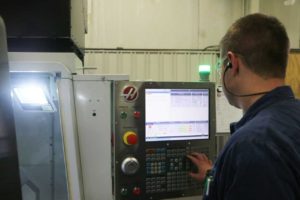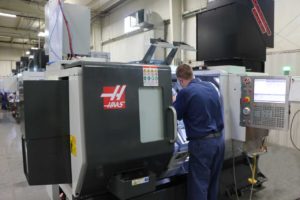At Koops, we are constantly looking for ways to improve our products, and it is with that goal in mind that we are excited to tell you about the latest addition to our Machining Department; the Computer Numerical Control Lathe – or CNC Lathe for short.
As you know, a lathe removes material by rotating a workpiece on a single axis of rotation. When controlled by a person, operating a lathe can take a good amount of time and is open to human error, creating lost manhours as well as possibly unusable pieces. We can program a sequence through the CNC Lathe that is then carried out to perfection every time, giving us maximum accuracy with minimal downtime. With the CNC Lathe's ability to sequence multiple actions, as well as its automatic tool presetter and spindle coolant system, we are able to produce high-quality parts at a rapid pace with little need for operator input.
This higher level of precision allows us to create the parts you require at a higher level of accuracy than ever before, and with a faster turnaround time. The CNC Lathe also gives us the ability to machine hardened steel components in-house, saving us the time and money that would have been lost with outsourcing the work.
All of this builds into the three promises we at Koops make to you:
Rock Solid Engineering Solutions
- The CNC Lathe improves the quality of the parts we offer
- The CNC Lathe cuts down on the time it will take to build the parts you need
- The CNC Lathe can create parts that far more accurate than a human hand could
Reliable Project Management
- The CNC Lathe allows us to create hardened steel components in-house
- The CNC Lathe increases efficiency and cuts down on labor costs
Excellent Customer Support
- The CNC Lathe gives us a new way to better meet your needs
 We hope that you can see the added benefits of the CNC Lathe. Our Machining Department has always been focused on producing high-quality components at a low cost, and the capabilities of the CNC Lathe helps us achieve this goal better than ever before.
We hope that you can see the added benefits of the CNC Lathe. Our Machining Department has always been focused on producing high-quality components at a low cost, and the capabilities of the CNC Lathe helps us achieve this goal better than ever before.
If you have any questions about the CNC Lathe or any of our other tools and capabilities, please contact our sales team at support@koops.com[:]
I n 1903, Henry Ford reimagined manufacturing, creating the first ever moving assembly line for mass production. Previously, a car took 12 hours to assemble, but after Ford’s innovation, it took two hours and 30 minutes. Since then, the history of production manufacturing is marked by continual advancements that redefine standards for efficiency, quality, speed, and accuracy. In more recent history, automation has been driving improvements in overall efficiency, cutting costs, and streamlining processes. Before making the investment, manufacturers need to decide when and what to automate to maximize the benefits.
n 1903, Henry Ford reimagined manufacturing, creating the first ever moving assembly line for mass production. Previously, a car took 12 hours to assemble, but after Ford’s innovation, it took two hours and 30 minutes. Since then, the history of production manufacturing is marked by continual advancements that redefine standards for efficiency, quality, speed, and accuracy. In more recent history, automation has been driving improvements in overall efficiency, cutting costs, and streamlining processes. Before making the investment, manufacturers need to decide when and what to automate to maximize the benefits.
Is it the right time?
A manufacturer first needs to determine if the ROI for automation justifies the expenditure. There are several primary justifications for automation that can help identify if it is the right time to automate.
- Minimize costs: Automation can minimize labor and training costs because employees receive training for the automation equipment instead of for multiple processes and machines on the line. This leads to less wasted materials and reduced expenses.
- Standardize and improve quality: Automation systems can easily, consistently, and precisely accomplish tasks that are hard to complete by hand, reducing the rate of piece part rejection. Furthermore, by implementing end-of-assembly testing equipment, total production manufacturing time can be minimized while quality is guaranteed.
- Reduce production times: Because production time is reduced, the work-in-process and finished goods inventories are also reduced. A manufacturer experiences a more flexible, improved response time if changes to the order or product are needed.
These three factors should help a manufacturer determine if it is time to automate. Since each automation system is completely customizable, a project manager can assist in identifying a solution that will optimize these benefits.
Which processes will benefit most?
A project manager will help decide which production manufacturing processes will benefit most from automation, but in the meantime, several factors can help manufacturers decide what to automate. Parts with the same or similar features and families of parts are top candidates for automation. Similarly, parts with the same or related processes greatly benefit from automation. If the current manufacturing production involves a flow line, which incorporates a partial or complete continual flow from station to station, an automation solution can further increase efficiency and reduce production time. In some cases, workspace integration can simplify and improve a flow line. Repeatable operations are also completed quickly and accurately with an automation solution. In general, if a part takes up around 80 percent of the volume and about 20 percent of parts numbers, production would benefit from automation.
These guidelines can help determine when and what to automate, but keep in mind that Koops, Inc. engineers can also customize a solution. No matter the scale of the project, an automation system can be tailored to each production manufacturing process, maximizing the benefits during each and every stage of production.
